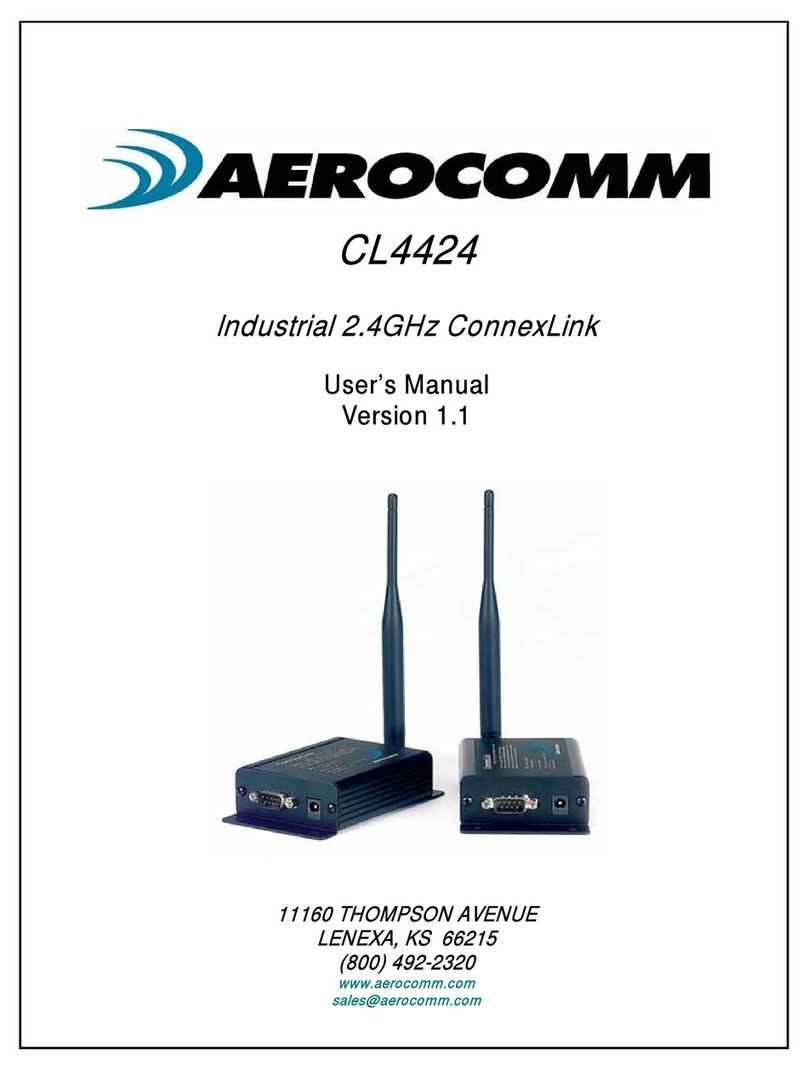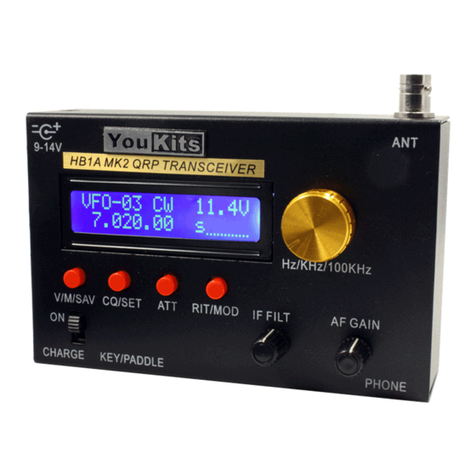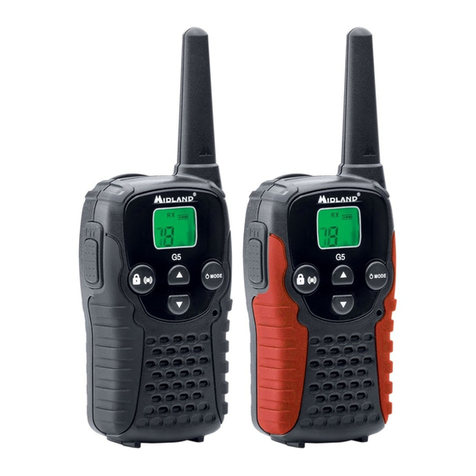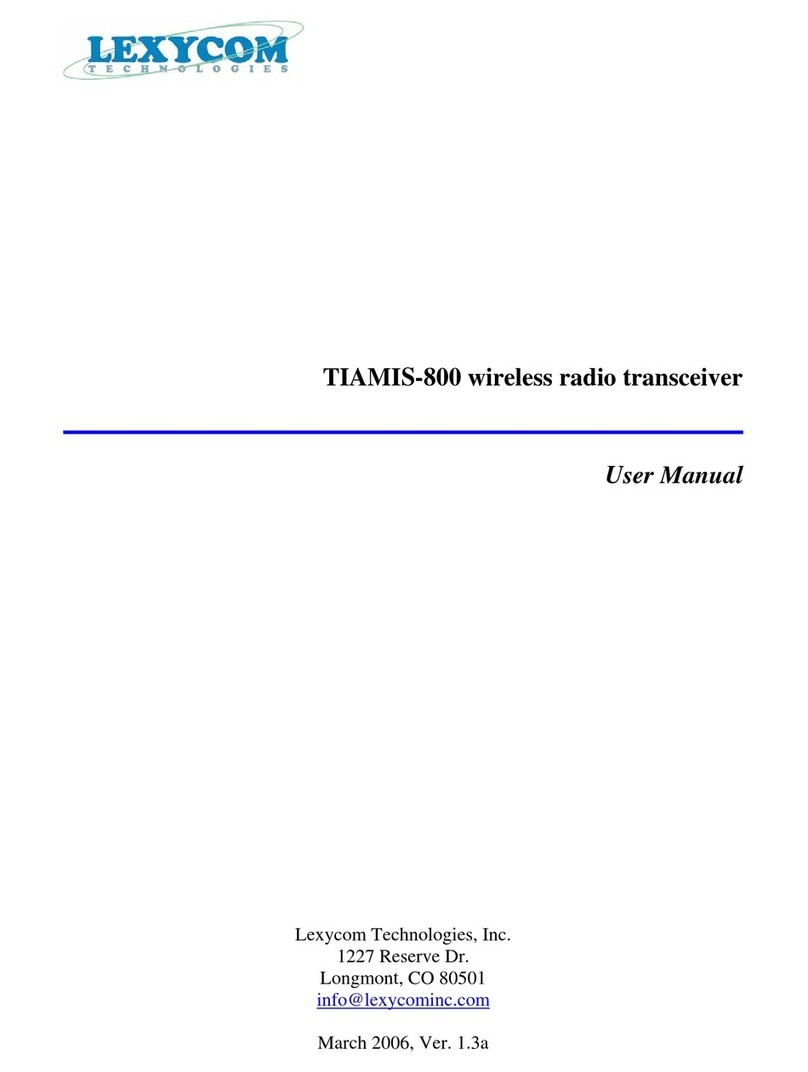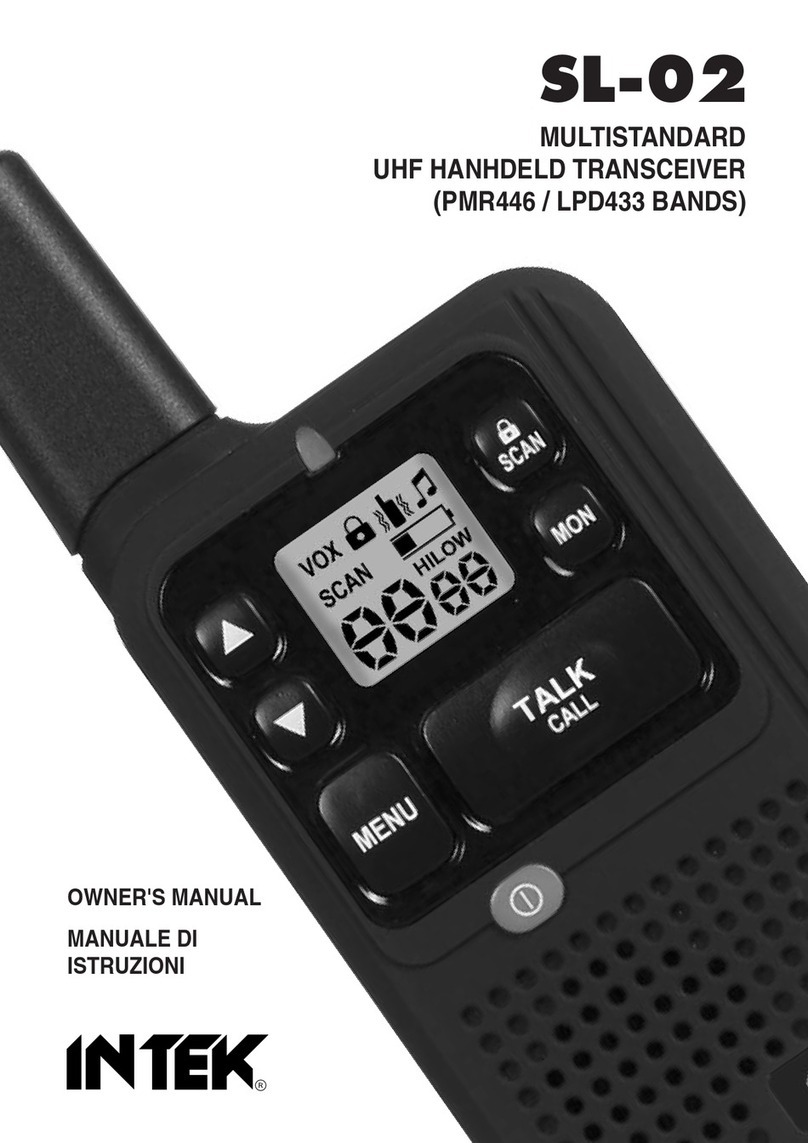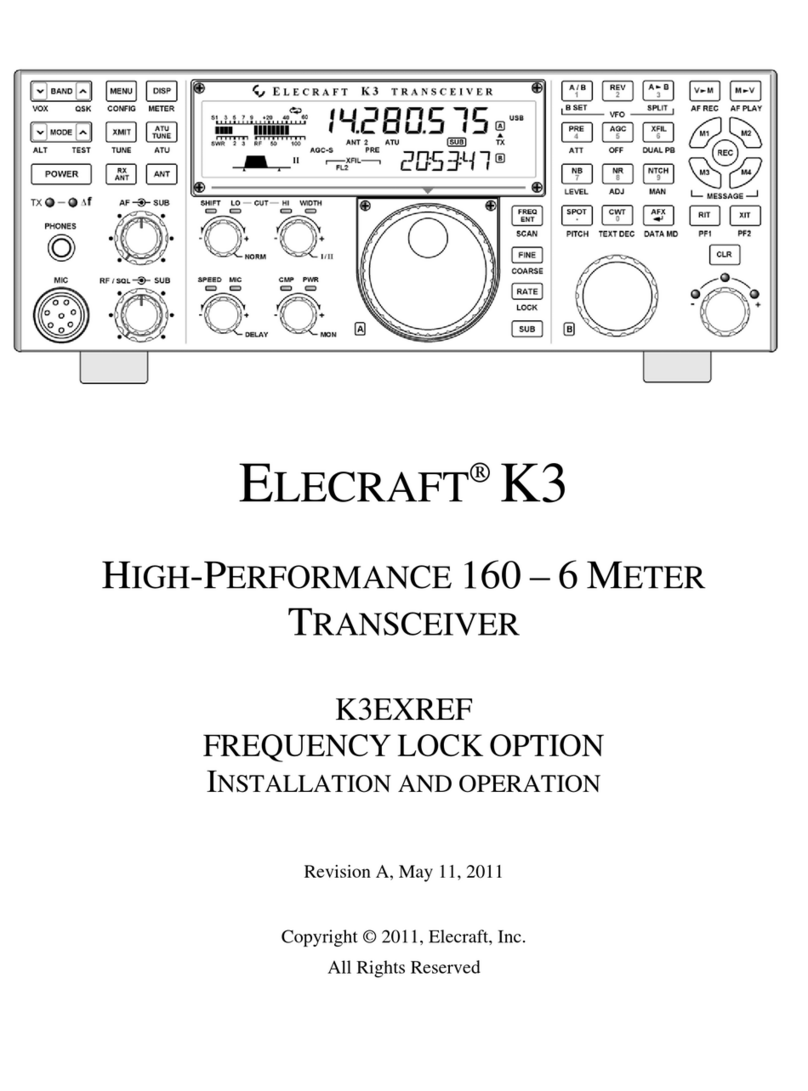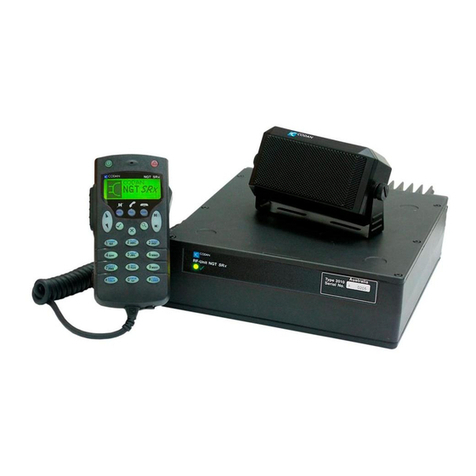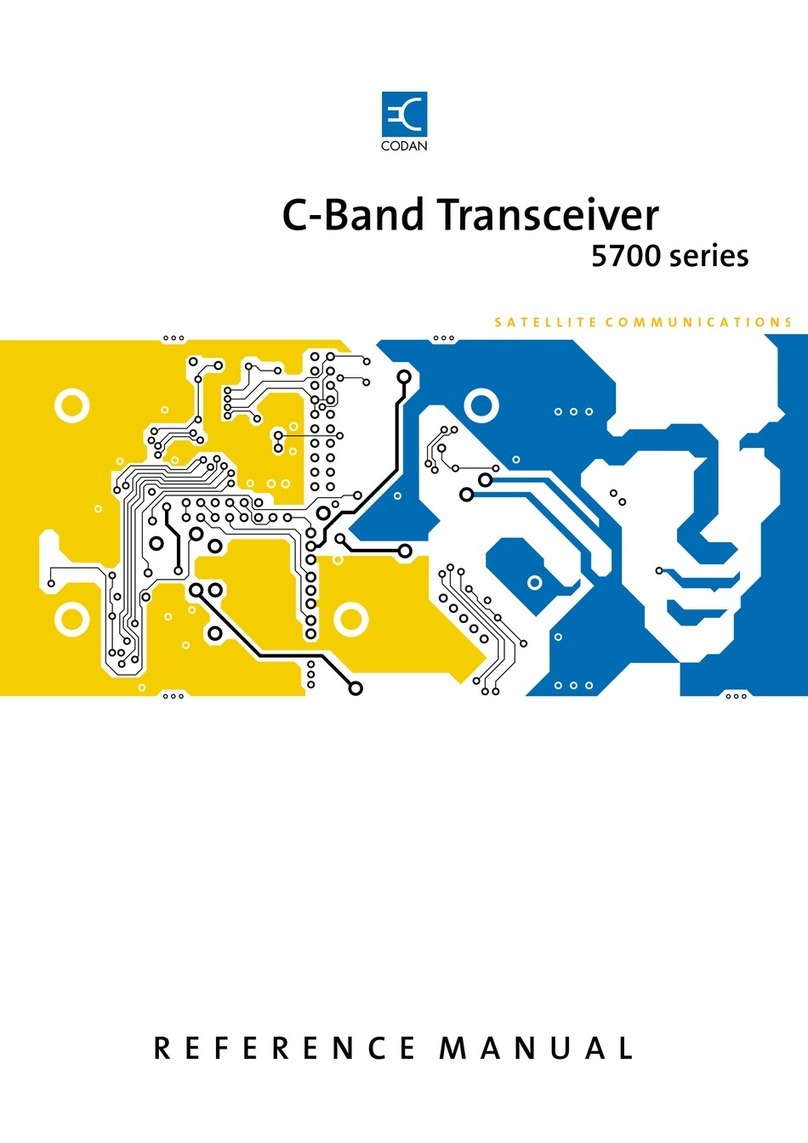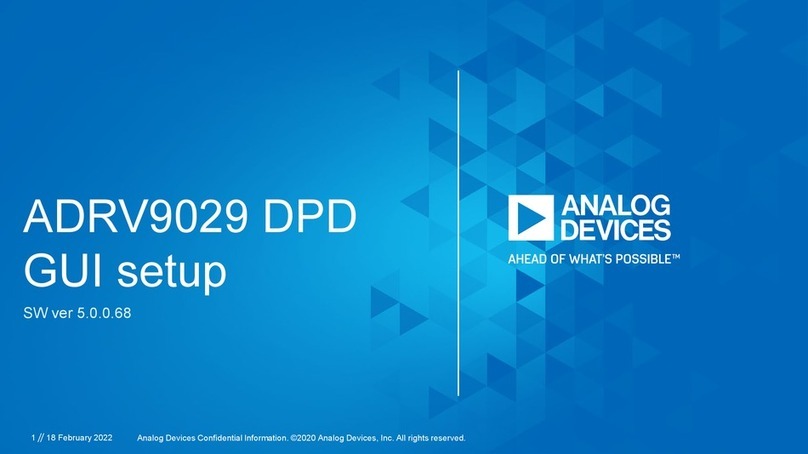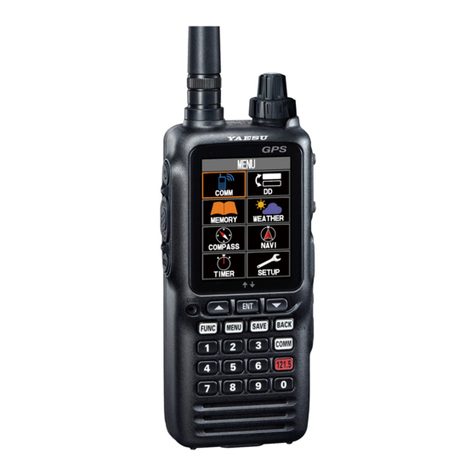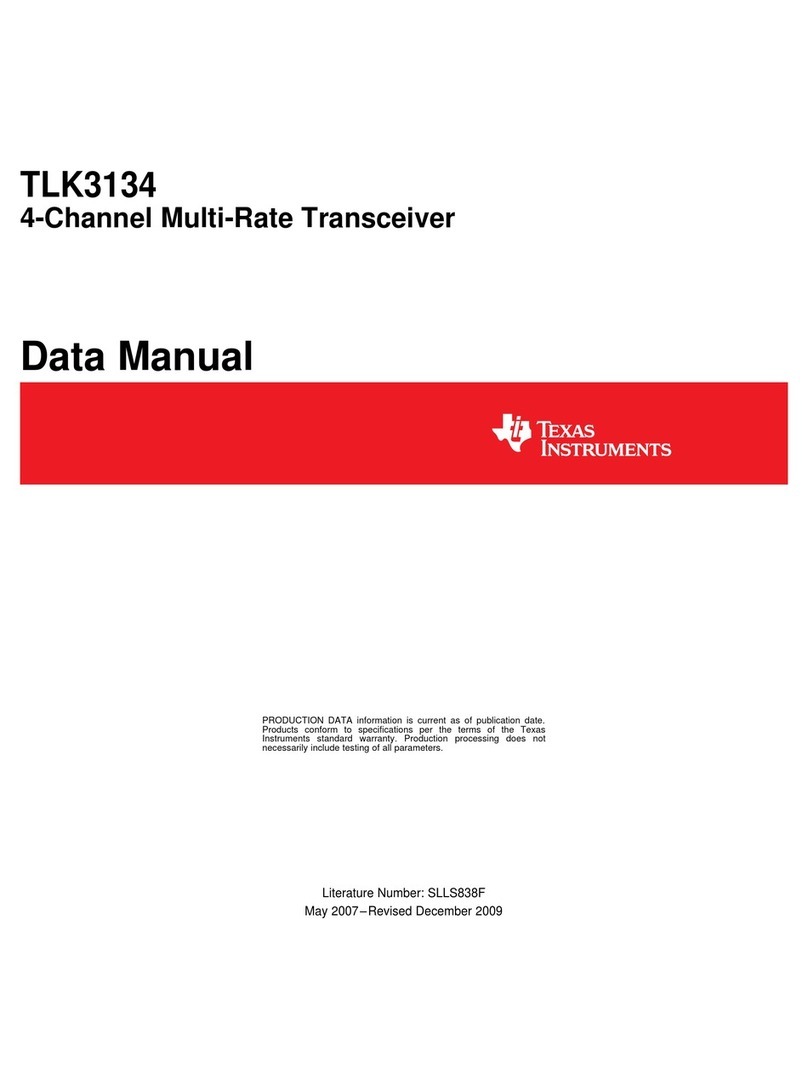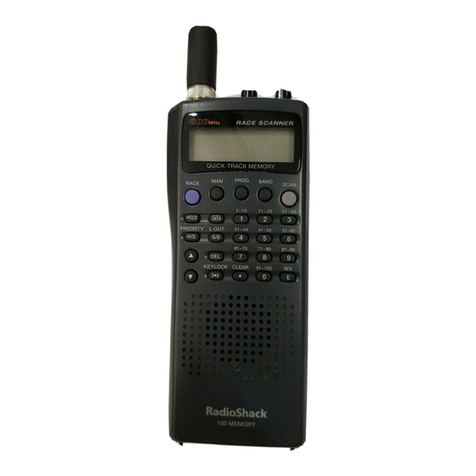AeroComm AC5124 User manual

AC5124
AC5124AC5124
AC5124
2.4 GHz OEM TRANSCEIVER
2.4 GHz OEM TRANSCEIVER2.4 GHz OEM TRANSCEIVER
2.4 GHz OEM TRANSCEIVER
Specifications Subject to Change
Specifications Subject to ChangeSpecifications Subject to Change
Specifications Subject to Change
User’s Manual
User’s ManualUser’s Manual
User’s Manual
Version 4.4
Version 4.4Version 4.4
Version 4.4
10981 EICHER DRIVE
10981 EICHER DRIVE10981 EICHER DRIVE
10981 EICHER DRIVE
LENEXA, KS 66219
LENEXA, KS 66219LENEXA, KS 66219
LENEXA, KS 66219
(800) 492-2320
(800) 492-2320(800) 492-2320
(800) 492-2320
www.aerocomm.com
www.aerocomm.comwww.aerocomm.com
www.aerocomm.com
wireless@aerocomm.com
wireless@aerocomm.comwireless@aerocomm.com
wireless@aerocomm.com

11/24/03 2
DOCUMENT INFORMATION
DOCUMENT INFORMATIONDOCUMENT INFORMATION
DOCUMENT INFORMATION
Copyright
CopyrightCopyright
Copyright
Information
InformationInformation
Information
Copyright © 2000 AEROCOMM, Inc. All rights reserved.
The information contained in this manual and the accompanying
software programs are copyrighted and all rights are reserved by
AEROCOMM, Inc. AEROCOMM, Inc. reserves the right to make
periodic modifications of this product without obligation to notify
any person or entity of such revision. Copying, duplicating, selling, or otherwise
distributing any part of this product without the prior consent of an authorized
representative of AEROCOMM, Inc. is prohibited.
All brands and product names in this publication are registered
trademarks or trademarks of their respective holders.
This material is preliminary
This material is preliminaryThis material is preliminary
This material is preliminary
Information furnished by AEROCOMM in this specification is believed to be accurate. Devices sold
by AEROCOMM are covered by the warranty and patent indemnification provisions appearing in its
Terms of Sale only. AEROCOMM makes no warranty, express, statutory, and implied or by
description, regarding the information set forth herein. AEROCOMM reserves the right to change
specifications at any time and without notice.
AEROCOMM’s products are intended for use in normal commercial applications. Applications
requiring extended temperature range or unusual environmental requirements such as military,
medical life-support or life-sustaining equipment are specifically not recommended without
additional testing for such application.

11/24/03 3
DOCUMENT INFORMATION
DOCUMENT INFORMATIONDOCUMENT INFORMATION
DOCUMENT INFORMATION
Revision
RevisionRevision
Revision Description
DescriptionDescription
Description
Version 3.6 Remove SDK developer kit information – 6/6/00
Re-arrange the layout of the specification to ease use
Correct Channels from 75 to 77 and provide range in Hex, Section 5.1.3
Version 3.7 6/28/00 – Made data rates uniform at 882 Kbps
Reformat I/O table to view additional line descriptions
Version 3.8 8/18/00 – Changed Input Voltage tolerance from 5% to 2%
Changed temperature from 0 – 60 °C to 0 – 70 °C
Changed Baud Low Default from F7 to F1
Updated Section 6 – API Command Set with examples & corrections
Added pin notations on Figure 1 - Mechanical Overview of AC5124C
Version 3.9 9/25/00 – Corrected DTR pin number from 33 to 34, Pin 33 is NC
Changed Pin 24 from Reserved to NC
Remove Note from the CTS timing diagram in Sections 3.3.1 & 4.6
Changed description for Diagnostic Result command in Section 6.1.3
Version 4.2 10/25/01 - Changed PKLR2400S part number to AC5124C
Added AC5124C-200 information
Added Section 3.3, Electrical Specifications
Added RSSI calibration steps in Section 3.2.1
Added Section 4.6, Addressed & Broadcast Communication
Added Section 4.7, Handshaking
Updated Table 6, EEPROM Parameters to include new parameters
Updated Section 5, API Command Set to include command examples
Updated Section 6, Configuring the AC5124C to include new parameter definitions
Added Section 7, Initializing the AC5124C Transceiver
Updated Section 8, Mechanical Overview to include new drawings
Version 4.3 3/25/01 – Changed Interface Timeout values in Table 6, EEPROM Parameters
Updated RF Mode 1 (EEPROM Address 4Ch) to include new definition for Bit 7
Added Section 6.1.15.5, Mixed Mode
Updated Approved Antenna List
Version 4.4 11/24/03 – Updated all references to operating temperature from 0°C to 60°C to -40°C to
80°C. All AC5124 products are industrial temperature. Added AT Commands for
reading and writing the EEPROM. Updated RSSI plot for new receiver IC.

11/24/03 4
FCC INFORMATION
FCC INFORMATIONFCC INFORMATION
FCC INFORMATION
Agency Approval Overview
Agency Approval OverviewAgency Approval Overview
Agency Approval Overview
Part Number
Part NumberPart Number
Part Number US/FCC
US/FCCUS/FCC
US/FCC CAN/IC
CAN/ICCAN/IC
CAN/IC EUR/EN**
EUR/EN**EUR/EN**
EUR/EN** Portable
PortablePortable
Portable Mobile
MobileMobile
Mobile
AC5124-10 X X X X X
AC5124-200 X X X-20cm*
* See RF Exposure warning on page 6
** Does not include France and Spain
Note: The product approvals above are with antennas specified on page 5.
Agency Identification Numbers
Agency Identification NumbersAgency Identification Numbers
Agency Identification Numbers
Part Number
Part NumberPart Number
Part Number US/FCC
US/FCCUS/FCC
US/FCC CAN/IC
CAN/ICCAN/IC
CAN/IC EUR/EN
EUR/ENEUR/EN
EUR/EN
AC5124-10 KQL-PKLR2400 CAN2268391158A X
AC5124-200 KQL-PKLR2400-200 CAN2268391180A
FCC Notice
FCC NoticeFCC Notice
FCC Notice
Antenna Warning
Antenna WarningAntenna Warning
Antenna Warning
WARNING:
WARNING:WARNING:
WARNING: This device complies with Part 15 of the FCC Rules. Operation is subject to the
following two conditions: (1) This device may not cause harmful interference
and (2) This device must accept any interference received, including
interference that may cause undesired operation.
WARNING:
WARNING:WARNING:
WARNING: This device has been tested with an MMCX connector with the antennas listed
below. When integrated in the OEMs product, these fixed antennas require
installation preventing end-users from replacing them with non-approved
antennas. Any antenna not in the following table must be tested to comply with
FCC Section 15.203 for unique antenna connectors and Section 15.247 for
emissions.

11/24/03 5
FCC INFORMATION
FCC INFORMATIONFCC INFORMATION
FCC INFORMATION
Approved Antenna List
Approved Antenna ListApproved Antenna List
Approved Antenna List
Item
ItemItem
Item Part Number
Part NumberPart Number
Part Number Manufacturer
ManufacturerManufacturer
Manufacturer Gain (dBi)
Gain (dBi)Gain (dBi)
Gain (dBi)
AC5124-10
AC5124-10AC5124-10
AC5124-10
AC5124-10A
AC5124-10AAC5124-10A
AC5124-10A
AC5124-200
AC5124-200AC5124-200
AC5124-200
AC5124-200A
AC5124-200AAC5124-200A
AC5124-200A
1 WCP-2400-MMCX Centurion 2 PM M
2 WCR-2400-SMRP Centurion 2 PM
3 MFB24008RPN Maxrad 8 PM
4 BMMG24000MSMARP12’ Maxrad 1 PM
5 BMMG24005MSMARP12’ Maxrad 5 PM
6 MP24013TMSMARP12 Maxrad 13 M
7 MUF24005M174MSMARP12 Maxrad 5 PM
8 MC2400 Maxrad 2.5 M
9 NZH2400-MMCX (External) AeroComm 1 PM M
10 NZH2400-I (Integrated) AeroComm 1 PM M
11 S131CL-5-RMM-2450S Nearson 2 M
12 S181FL-5-RMM-2450S Nearson 2 PM M
13 S191FL-5-RMM-2450S Nearson 3 PM M
14 S151FL-5-RMM-2450S Nearson 5 PM M
15 MLPV1700 Maxrad 4 PM M
P=Portable, M=Mobile
P=Portable, M=MobileP=Portable, M=Mobile
P=Portable, M=Mobile

11/24/03 6
FCC INFORMATION
FCC INFORMATIONFCC INFORMATION
FCC INFORMATION
Labeling Requirements
Labeling RequirementsLabeling Requirements
Labeling Requirements
RF Exposure AC5124-10
RF Exposure AC5124-10RF Exposure AC5124-10
RF Exposure AC5124-10
RF Exposure AC5124-200
RF Exposure AC5124-200RF Exposure AC5124-200
RF Exposure AC5124-200
WARNING:
WARNING:WARNING:
WARNING: The Original Equipment Manufacturer (OEM) must ensure that FCC labeling
requirements are met. This includes a clearly visible label on the outside of the
OEM enclosure specifying the appropriate AeroComm FCC identifier for this
product as well as the FCC Notice above. The FCC identifiers are listed above
in the Agency Identifier Numbers section.
WARNING:
WARNING:WARNING:
WARNING: This equipment has been approved for portable applications where the
equipment can be used in direct contact with the human body. Excessive RF
exposure should be avoided.
The preceding statement must be included as a CAUTION statement in
manuals for products operating with Antennas 3, 4, 5, 6, 7, 14 and 15 in the
previous table to alert users on FCC RF Exposure compliance.
WARNING:
WARNING:WARNING:
WARNING: To satisfy FCC RF exposure requirements for mobile and base station
transmitting devices, a separation distance of 20cm or more should be
maintained between the antenna of this device and persons during operation.
To ensure compliance, operations at closer than this distance is not
recommended.
The preceding statement must be included as a CAUTION statement in
manuals for OEM products to alert users on FCC RF Exposure compliance.

11/24/03 7
TABLE OF CONTENTS
TABLE OF CONTENTSTABLE OF CONTENTS
TABLE OF CONTENTS
TABLES......................................................................................................................................................... 8
1. OVERVIEW........................................................................................................................................ 10
2. AC5124 SPECIFICATIONS.............................................................................................................. 11
3. THEORY OF OPERATION.............................................................................................................. 12
1.1 DEFINITIONS .................................................................................................................................. 12
1.2 INTERFACE SIGNAL DEFINITIONS ................................................................................................... 13
1.2.1 Received Signal Strength Indicator (RSSI)........................................................................... 14
1.1.2 In Range (IN_RANGE).......................................................................................................... 15
1.1.3 Baud Rate Selector (BDSEL)................................................................................................ 15
1.1.4 Microprocessor Reset (µP_RESET)...................................................................................... 15
1.1.5 EEPROM Write Enable (WR_ENA)...................................................................................... 15
1.3 ELECTRICAL SPECIFICATIONS......................................................................................................... 16
4. SERIAL INTERFACE MODES........................................................................................................17
4.1 SERIAL INTERFACE MODE 01 – TRANSPARENT, FIXED PACKET LENGTH, WITH TIMEOUT............. 17
4.2 SERIAL INTERFACE MODE 02 – TRANSPARENT, END CHARACTER ................................................ 17
4.3 SERIAL INTERFACE MODE 03 – API ..............................................................................................18
4.4 SERIAL INTERFACE MODE 04 – TRANSPARENT, FIXED PACKET LENGTH,NO TIMEOUT ................ 18
4.5 SERIAL INTERFACE BUFFER ........................................................................................................... 18
4.6 ADDRESSED & BROADCAST COMMUNICATION.............................................................................. 18
4.6.1 Addressed Mode.................................................................................................................... 19
4.6.2 Broadcast Mode.................................................................................................................... 20
4.7 HANDSHAKING............................................................................................................................... 20
4.7.1 CTS Handshaking ................................................................................................................. 20
4.7.2 RTS Handshaking.................................................................................................................. 21
4.7.3 Modem Handshaking ............................................................................................................ 21
5. API COMMAND SET........................................................................................................................ 22
5.1 SYSTEM COMMAND SET ................................................................................................................ 23
5.1.1 Reset...................................................................................................................................... 23
5.1.2 Control.................................................................................................................................. 24
5.1.3 Diagnostic Result.................................................................................................................. 24
5.1.4 Standby.................................................................................................................................. 25
5.1.5 Status Request....................................................................................................................... 25
5.1.6 Status Reply........................................................................................................................... 25
5.1.7 Update EEPROM Checksum................................................................................................. 26
5.1.8 Check EEPROM Checksum .................................................................................................. 26
5.1.9 EEPROM Checksum Status...................................................................................................26
5.1.10 Acknowledge......................................................................................................................... 27
5.2 TRANSCEIVER COMMAND SET....................................................................................................... 27
5.2.1 RF Enable............................................................................................................................. 27
5.2.2 Send Data.............................................................................................................................. 28
5.2.3 Send Data Complete ............................................................................................................. 28
5.2.4 Received Data....................................................................................................................... 29
5.2.5 In Range................................................................................................................................ 29
5.2.6 Out of Range......................................................................................................................... 29
6. AT COMMAND SET......................................................................................................................... 30
6.1 IRAM DEFINED............................................................................................................................. 30

11/24/03 8
6.2 COMMAND INSTRUCTIONS/RESPONSES.......................................................................................... 30
6.2.1 Enter Command Mode.......................................................................................................... 31
6.2.2 Exit Command Mode............................................................................................................. 31
6.2.3 Power-on Reset Command.................................................................................................... 32
6.2.4 Read IRAM Byte.................................................................................................................... 32
6.2.5 Write IRAM Byte................................................................................................................... 33
6.2.6 Read EEPROM Byte ............................................................................................................. 34
6.2.7 Write EEPROM Byte............................................................................................................. 35
7. CONFIGURING THE AC5124......................................................................................................... 36
7.1.1 Software Version Number..................................................................................................... 39
7.1.2 IEEE MAC Address............................................................................................................... 39
7.1.3 Channel................................................................................................................................. 40
7.1.4 Transmit Attempts................................................................................................................. 40
7.1.5 Receive Mode........................................................................................................................ 40
7.1.6 Range Refresh....................................................................................................................... 41
7.1.7 Server/Client Mode............................................................................................................... 41
7.1.8 System ID.............................................................................................................................. 42
7.1.9 End Character....................................................................................................................... 42
7.1.10 Baud High (BH) and Baud Low (BL).................................................................................... 43
7.1.11 Fixed Packet Length High & Low......................................................................................... 43
7.1.12 Random Back-Off.................................................................................................................. 44
7.1.13 Serial Interface Mode............................................................................................................ 44
7.1.14 Transmit Mode...................................................................................................................... 47
7.1.15 RF Mode 1 ............................................................................................................................ 47
7.1.16 Read Switches ....................................................................................................................... 48
7.1.17 Interface Timeout.................................................................................................................. 50
7.1.18 Broadcast Attempts............................................................................................................... 50
7.1.19 RF Mode ............................................................................................................................... 50
7.1.20 Destination IEEE MAC Address........................................................................................... 52
7.1.21 Sleep Time............................................................................................................................. 52
7.1.22 Wait Time.............................................................................................................................. 52
8. INITIALIZING THE AC5124 TRANSCEIVER ............................................................................. 53
8.1 TRANSPARENT MODE INITIALIZATION ........................................................................................... 53
8.2 API MODE INITIALIZATION............................................................................................................ 53
9. MECHANICAL OVERVIEW...........................................................................................................55
10. ORDERING INFORMATION...................................................................................................... 57
10.1 PRODUCT PART NUMBERS............................................................................................................. 57
10.2 DEVELOPER KIT PART NUMBERS................................................................................................... 57
Figures
FiguresFigures
Figures
Figure 1 - RSSI Voltage vs. Received Signal Strength..........................................................................14
Figure 2 - API Mode Initialization..............................................................................................................54
Figure 3 – AC5124 with MMCX.................................................................................................................55
Figure 4 – AC5124 with Integral Antenna................................................................................................56
Tables
TablesTables
Tables
Table 1 - Interface Signal Definitions .......................................................................................................13
Table 2 - DC Input Voltage Characteristics.............................................................................................16
Table 3 - DC Output Voltage Characteristics..........................................................................................16
Table 4 - System Command Set ..............................................................................................................23

11/24/03 9
Table 5 - Transceiver Command Set.......................................................................................................27
Table 6 - EEPROM Parameters ................................................................................................................37
Table 7 - BH/BL Selections For Common Baud Rates .........................................................................43

AC5124-10 Specifications
AC5124-10 SpecificationsAC5124-10 Specifications
AC5124-10 Specifications
11/24/03 10
1.
1.1.
1. Overview
OverviewOverview
Overview
This document contains information about the hardware and software interface between an
AeroComm AC5124 transceiver and an OEM Host. Information includes the theory of operation,
system issues, and a basic command set for operational control of the system and transceiver.
The transceiver is designed to allow flexibility at the hardware interface level with a minimum number of
actual hardware pins connecting the transceiver and the OEM Host. The transceiver is controlled by a
Temic TS87C51U2 microcontroller providing program storage. A separate EEPROM provides user
configurable parameter storage.
AC5124 transceivers operate in a Point-to-Point or Point-to-Multipoint, Client/Server architecture. One
transceiver is configured as a Server and the others are configured as Clients. Data can be transmitted
from Client to Server or Server to Client, but not from Client to Client, or Server to Server.
The AC5124 runs a proprietary Carrier Sense Multiple Access (CSMA) protocol. Years of
development, testing and field operation have proven this protocol to be a stable, reliable and efficient
method for wireless network communications. Furthermore, the AeroComm protocol is configurable,
allowing the OEM to optimize system performance. There are four different Serial Interface Modes
provided by the protocol firmware. These Modes offer significant flexibility to the OEM, allowing them
to provide data in many forms including API, End Character and Fixed Packet Length with and without
Timeouts.

AC5124-10 Specifications
AC5124-10 SpecificationsAC5124-10 Specifications
AC5124-10 Specifications
11/24/03 11
2.
2.2.
2. AC5124 Specifications
AC5124 SpecificationsAC5124 Specifications
AC5124 Specifications
GENERAL
GENERALGENERAL
GENERAL
Bus Interface Serial (TTL Level Asynchronous) through 40 pin mini
connector. AMP P/N 177986-1
Serial Interface Data Rate Programmable to 882 Kbps. PC rates to 115.2 Kbps
Compliance
AC5124-10
Certifiable under:
US (FCC 15.247); Canada (IC); Europe (EN)
AC5124-200 US (FCC 15.247); Canada (IC)
Power Consumption
All Serial Interface Modes
Interface ON/RF OFF (API Mode Only)
Sleep Walk (Clients in all Modes Only)
Deep Sleep (Servers in API Mode Only)
Duty Cycle (TX=Transmit; RX=Receive
Duty Cycle (TX=Transmit; RX=ReceiveDuty Cycle (TX=Transmit; RX=Receive
Duty Cycle (TX=Transmit; RX=Receive)
))
)
25%TX
25%TX25%TX
25%TX
50%TX
50%TX50%TX
50%TX
100%TX
100%TX100%TX
100%TX
100%RX
100%RX100%RX
100%RX
AC5124-10: 111mA 123mA 158mA 100mA
AC5124-200: 185mA 280mA 472mA 110mA
45mA typical
25mA typical
20mA typical
Channels Supports 77 non-interfering channels
Security User assigned System ID. Unique IEEE addresses on each
transceiver.
TRANSCEIVER
TRANSCEIVERTRANSCEIVER
TRANSCEIVER
Frequency Band 2.402 – 2.478 GHz
Transceiver Type Frequency Hopping Spread Spectrum
Output Power
AC5124-10
AC5124-200
10mW
200mW
Input Voltage 5V nominal +2%, + 50mV ripple
Sensitivity -90dBm
RF Data Rate 882 Kbps
Range
AC5124-10
AC5124-200
Can be extended with directional antenna
Indoors up to 300 ft., Outdoors up to 3,000 ft.
Indoors up to 500 ft., Outdoors up to 10,000 ft.
Synchronization Time Average = 750ms; Maximum = 1.5s
ENVIRONMENTAL
ENVIRONMENTALENVIRONMENTAL
ENVIRONMENTAL
Temperature (Operating) -40°C to +80°C
Temperature (Storage) -50°C to +85°C
Humidity (non-condensing) 10% to 90%
PHYSICAL
PHYSICALPHYSICAL
PHYSICAL
Dimensions 1.65” x 2.65” x 0.20”
Antenna Connector Standard MMCX jack
Weight Less than 0.75 ounces
SOFTWARE
SOFTWARESOFTWARE
SOFTWARE
User Configurable Options
Host Interface Data Rate Up to 882 Kbps
Maximum bi-directional throughput Up to 170kbps
Variable Packet Length Up to 2 KBytes
Serial Interface Modes (3) Transparent and (1) API
Diagnostic Error Counters API Mode
User Programmable Attempts Up to 255

AC5124-10 Specifications
AC5124-10 SpecificationsAC5124-10 Specifications
AC5124-10 Specifications
11/24/03 12
3.
3.3.
3. Theory of Operation
Theory of OperationTheory of Operation
Theory of Operation
The AC5124 has a serial interface that allows the OEM Host to send and receive communications to
and from the transceiver. All I/O is 5Vdc TTL level signals except for RSSI, which is an analog output.
All outputs are weakly pulled logic high (20 kΩ– 50 kΩ) when left unconnected and are driven logic
high at reset.
3.1
3.13.1
3.1 D
DD
DEFINITIONS
EFINITIONSEFINITIONS
EFINITIONS
Server Host:
Server Host:Server Host:
Server Host:
The Server Host is the OEM device controlling the Server transceiver.
Client Host:
Client Host:Client Host:
Client Host: The Client Host is the OEM device controlling the Client transceiver.
Host:
Host:Host:
Host: Host refers to both the Server Host and the Client Host.
Server Transceiver:
Server Transceiver:Server Transceiver:
Server Transceiver:
The Server transceiver is the “Master” transceiver. It is the hub of all
communications.
Client Transceiver:
Client Transceiver:Client Transceiver:
Client Transceiver: The Client transceiver is a “Slave” transceiver. It is controlled by it’s own
Host, but is a slave to the Server transceiver.
Authentication:
Authentication:Authentication:
Authentication: The acquisition of a Server IEEE 802.3 address by a Client transceiver and a
subsequent issue of an
In Range
In RangeIn Range
In Range
command by the Client transceiver to the Client Host.
Unicast Address:
Unicast Address:Unicast Address:
Unicast Address: A frame that is directed to a single recipient as specified in IEEE 802.3.
Broadcast Address:
Broadcast Address:Broadcast Address:
Broadcast Address: A frame that is directed to multiple recipients as specified in IEEE 802.3.

AC5124-10 Specifications
AC5124-10 SpecificationsAC5124-10 Specifications
AC5124-10 Specifications
11/24/03 13
3.2
3.23.2
3.2 I
IIINTERFACE
NTERFACENTERFACE
NTERFACE S
SS
SIGNAL
IGNALIGNAL
IGNAL D
DD
DEFINITIONS
EFINITIONSEFINITIONS
EFINITIONS
The following pinout is for the 40-pin mini-connector, J1 (AMP P/N 177986-1). I/O direction is with
regard to the transceiver. All pins not used by the OEM may be left floating.
Table
TableTable
Table 1
11
1 - Interface Signal Definitions
- Interface Signal Definitions- Interface Signal Definitions
- Interface Signal Definitions
Pin
PinPin
Pin Type
TypeType
Type Signal Name
Signal NameSignal Name
Signal Name Function
FunctionFunction
Function
1 GND GND Signal Ground
2 I PKTMODE Logic low (Active Low) will force transceiver into “pseudo” Serial Interface
Mode 03 (API). Used for programming the EEPROM. Not recommended for
full API Mode operation. See Section 6, Configuring the AC5124
Section 6, Configuring the AC5124Section 6, Configuring the AC5124
Section 6, Configuring the AC5124.
3 VCC VCC 5V + 2%, ±50 mV ripple
4 NC NC No Connect
5 VCC VCC 5V + 2%, ±50 mV ripple
6 NC NC No Connect
7 NC NC No Connect
8 NC NC No Connect
9 NC NC No Connect
10 NC NC No Connect
11 O RSSI Received Signal Strength Indicator - Analog output giving relative indication
of received signal strength while in receive mode.
12 NC NC No Connect
13 NC NC No Connect/Data 7
14 O TXD Transmitted data out of the transceiver
15 O IN_RANGE Logic low when a Client detects a Server with same Channel and System ID.
16 I RXD Data input to the transceiver
17 I RI_IN Ring Indicator to communicate to modem
18 NC NC No Connect
19 O RI_OUT Ring Indicator to communicate to computer
20 GND GND Ground
21 GND GND Ground
22 I DCD_IN Data Carrier Detect to communicate to modem
23 O CTS Clear to Send – Logic Low (Active Low) when the transceiver is ready to
accept data for transmission. See Section 4.7.1, CTS Handshaking
Section 4.7.1, CTS HandshakingSection 4.7.1, CTS Handshaking
Section 4.7.1, CTS Handshaking.
24 NC NC No Connect
25 Reserved Reserved Reserved, must be left floating and not connected to logic high or low.
26 I BDSEL Baud Select – Logic low (Active Low) will force the transceiver into a known
serial interface baud rate (9600 8-N-1)
27 I RTS Request to Send – Logic low (Active Low) when enabled and Host is ready
to receive data from the transceiver. See Section 4.7.2, RTS Handshaking
Section 4.7.2, RTS HandshakingSection 4.7.2, RTS Handshaking
Section 4.7.2, RTS Handshaking.
28 NC NC No Connect
29 NC NC No Connect
30 NC NC No Connect
31 NC NC No Connect
32 O DSR Data Set Ready
33 NC NC No Connect
34 I DTR Data Terminal Ready
35 NC NC No Connect
36 O DCD_OUT Data Carrier Detect to communicate to computer
37 I WR_ENA EEPROM Write Enable – Logic low will enable writes to the EEPROM.
The transceiver should NOT
NOTNOT
NOT be write-enabled during the initial power up
or upon a hardware reset to ensure the integrity of the EEPROM data.
38 I µP _RESET Microprocessor Reset - Logic high for a minimum of 2ms will reset the
transceiver. If a reset is performed after power has been applied and is stable,
the reset time will decrease significantly. All other times, Pin 38 should be
logic low. If Pin 38 is not connected, the microprocessor will hold Pin 38 logic
low.
39 VCC VCC 5V + 2%, ±50 mV ripple
40 GND GND Signal Ground
I = Input to the transceiver
O = Output from the transceiver

AC5124-10 Specifications
AC5124-10 SpecificationsAC5124-10 Specifications
AC5124-10 Specifications
11/24/03 14
3.2.1
3.2.13.2.1
3.2.1
Received Signal Strength Indicator (RSSI)
Received Signal Strength Indicator (RSSI)Received Signal Strength Indicator (RSSI)
Received Signal Strength Indicator (RSSI)
The Received Signal Strength Indicator is used by the Host to determine the instantaneous signal
strength at the receiver. The Host must calibrate RSSI without a signal being presented to the receiver.
RSSI is invalid when a transceiver is transmitting. Calibration is accomplished by following the steps
listed below to find a minimum and maximum voltage value.
1) Power up only one transceiver in the coverage area.
2) Measure the RSSI signal to obtain the minimum value with no other signal present.
3) Power up a transceiver that is the opposite type of the one measured in Step 2 (i.e. if the
transceiver was a Client, power up a Server, otherwise power up a Client). Make sure the
two transceivers are in close proximity and measure RSSI to obtain a maximum value at
full signal strength.
Figure 1 shows approximate RSSI performance. There are two versions of receivers used by the
AC5124. As of January of 2003 forward, only the New Revision receiver will be shipped. The RSSI pin
of the old revision requires the Host to provide a 27kΩpull-down to ground. No pull-down should be
used with the new revision.
Figure
FigureFigure
Figure 1
11
1 - RSSI Voltage vs. Received Signal Strength
- RSSI Voltage vs. Received Signal Strength- RSSI Voltage vs. Received Signal Strength
- RSSI Voltage vs. Received Signal Strength
0
1
2
3
4
5
6
-20
-25
-30
-35
-40
-45
-50
-55
-60
-65
-70
-75
-80
-85
-90
-95
Input Power (dBm)
Voltage (V)
New Revision Old Revision

AC5124-10 Specifications
AC5124-10 SpecificationsAC5124-10 Specifications
AC5124-10 Specifications
11/24/03 15
3.2.2
3.2.23.2.2
3.2.2
In Range (IN_RANGE)
In Range (IN_RANGE)In Range (IN_RANGE)
In Range (IN_RANGE)
The IN_RANGE pin will be driven logic low when a Client is in range of a Server on the same Channel
and System ID. If a Client cannot hear a Server for the amount of time that is programmed in the
Range Refresh EEPROM address 32h, the Client drives the IN_RANGE pin logic high and enters a
search mode looking for a Server. As soon as it detects a Server, the IN_RANGE pin will be driven
logic low.
3.2.3
3.2.33.2.3
3.2.3
Baud Rate Selector (BDSEL)
Baud Rate Selector (BDSEL)Baud Rate Selector (BDSEL)
Baud Rate Selector (BDSEL)
The Baud Rate Selector (BDSEL) pin provides the OEM a default method of communicating with a
transceiver in the event the EEPROM baud rate parameters become corrupted. If Pin 26 is logic high
or not connected, the baud rate will default to that specified in EEPROM. If Pin 26 is logic low at
RESET, the baud rate will default to 9600 baud.
3.2.4
3.2.43.2.4
3.2.4
Microprocessor Reset (µP_RESET)
Microprocessor Reset (µP_RESET)Microprocessor Reset (µP_RESET)
Microprocessor Reset (µP_RESET)
Microprocessor Reset (µP_RESET) is achieved by holding Pin 38 at logic high for a minimum of 2ms.
If µP_RESET is performed after power has been applied to a transceiver and is stable, the reset time
will be significantly less. At all other times, Pin 38 should be logic low. If Pin 38 is not connected, the
microprocessor will hold Pin 38 logic low.
3.2.5
3.2.53.2.5
3.2.5
EEPROM Write Enable (WR_ENA)
EEPROM Write Enable (WR_ENA)EEPROM Write Enable (WR_ENA)
EEPROM Write Enable (WR_ENA)
EEPROM Write Enable (WR_ENA) is enabled when Pin 37 is logic low. Pin 37 must be logic low to
write to the EEPROM. The OEM must ensure a transceiver is NOT write-enabled during initial power
up or during a hardware RESET. Failure to do so may result in corruption of important EEPROM data.

AC5124-10 Specifications
AC5124-10 SpecificationsAC5124-10 Specifications
AC5124-10 Specifications
11/24/03 16
3.3
3.33.3
3.3 E
EE
ELECTRICAL
LECTRICALLECTRICAL
LECTRICAL S
SS
SPECIFICATIONS
PECIFICATIONSPECIFICATIONS
PECIFICATIONS
Table
TableTable
Table 2
22
2 - DC Input Voltage Characteristics
- DC Input Voltage Characteristics- DC Input Voltage Characteristics
- DC Input Voltage Characteristics
Pin
PinPin
Pin Type
TypeType
Type Name
NameName
Name High Min.
High Min.High Min.
High Min. High Max.
High Max.High Max.
High Max. Low Min.
Low Min.Low Min.
Low Min. Low Max.
Low Max.Low Max.
Low Max. Unit
UnitUnit
Unit
2 I PKTMODE 0.2Vcc + 0.9 Vcc + 0.5 -0.5 0.2Vcc - 0.1 V
16 I RXD 0.2Vcc + 0.9 Vcc + 0.5 -0.5 0.2Vcc - 0.1 V
17 I RI_IN 2 Vcc + 1 -0.5 0.8 V
22 I DCD_IN 2 Vcc + 1 -0.5 0.8 V
26 I BDSEL 0.2Vcc + 0.9 Vcc + 0.5 -0.5 0.2Vcc - 0.1 V
27 I RTS 0.2Vcc + 0.9 Vcc + 0.5 -0.5 0.2Vcc - 0.1 V
34 I DTR 2 Vcc + 1 -0.5 0.8 V
37 I WR_ENA 0.7Vcc Vcc + 1 -0.3 0.5 V
38 I µP_RESET 0.7Vcc Vcc + 0.5 -0.5 0.2Vcc - 0.1 V
Table
TableTable
Table 3
33
3 - DC Output Voltage Characteristics
- DC Output Voltage Characteristics- DC Output Voltage Characteristics
- DC Output Voltage Characteristics
Pin
PinPin
Pin Type
TypeType
Type Name
NameName
Name High Min.
High Min.High Min.
High Min. Low Max.
Low Max.Low Max.
Low Max. Unit
UnitUnit
Unit
11 O RSSI Analog Analog V
14 O TXD Vcc - 1.5 @ -60uA 0.45 @ 1.6mA V
15 O IN_RANGE 2.4 @ -4mA 0.45 @ 4mA V
19 O RI_OUT 2.4 @ -4mA 0.45 @ 4mA V
23 O CTS Vcc - 1.5 @ -60uA 0.45 @ 1.6mA V
32 O DSR 2.4 @ -4mA 0.45 @ 4mA V
36 O DCD_OUT 2.4 @ -4mA 0.45 @ 4mA V

AC5124-10 Specifications
AC5124-10 SpecificationsAC5124-10 Specifications
AC5124-10 Specifications
11/24/03 17
4.
4.4.
4. Serial Interface Modes
Serial Interface ModesSerial Interface Modes
Serial Interface Modes
The AC5124 provides four Serial Interface Modes for interfacing to the Host, each having protocol
parameters that can be programmed for maximum system optimization. Serial Interface Modes 01, 02,
and 04 are referred to as Transparent Modes, indicating Host protocol is unnecessary for operation in
these modes – much like a serial cable. In addition, the transceiver-to-transceiver protocol for the
Transparent Modes is identical, allowing all three modes to coexist in the same network. Serial
Interface Mode 03, referred to as API Mode, is not interoperable with the Transparent Modes.
4.1
4.14.1
4.1 S
SS
SERIAL
ERIALERIAL
ERIAL I
IIINTERFACE
NTERFACENTERFACE
NTERFACE M
MM
MODE
ODEODE
ODE 01 – T
01 – T01 – T
01 – TRANSPARENT
RANSPARENTRANSPARENT
RANSPARENT, F
, F, F
, FIXED
IXEDIXED
IXED P
PP
PACKET
ACKETACKET
ACKET L
LL
LENGTH
ENGTHENGTH
ENGTH,
,,
, WITH
WITHWITH
WITH T
TT
TIMEOUT
IMEOUTIMEOUT
IMEOUT
Transparent Mode 01 is the most popular interface mode because it can be used for many serial cable
replacement applications that meet any or all of the following conditions:
1) The Host always sends data packets that are the same size, allowing a transceiver to
take advantage of the fixed packet length option.
2) The Host sends variable-sized data packets, all of which are equal to or smaller than the
Fixed Packet Length. A transceiver will wait until the Interface Timeout expires or until the
Fixed Packet Length size is reached. Therefore, if multiple packets and/or portions of
packets are sent before the Interface Timeout expires, the receiving transceiver Host
must be able to process the multiple packets and/or portions of packets.
Packets will be transmitted over the RF interface when one of the following conditions occurs:
1) The number of data bytes received over the serial interface is equal to the Fixed Packet
Length specified by the OEM at EEPROM addresses 43h and 44h (43h is the MSB). The
maximum packet size is 07FFh or 2KB.
2) A byte gap larger than the Interface Timeout specified by the OEM at EEPROM address
4Dh occurs. This can be set to 00h, 40h, 80h, or C0h designating 4ms, 40ms, 300ms,
and 2.6s timeouts, respectively.
Any packets larger than the Fixed Packet Length will be parsed and sent consecutively by a
transceiver. For example, if the Fixed Packet Length is 128 bytes and the Host sends 150 bytes,
a transceiver will send 128 bytes and then 22 bytes after the timeout expires, consecutively.
4.2
4.24.2
4.2 S
SS
SERIAL
ERIALERIAL
ERIAL I
IIINTERFACE
NTERFACENTERFACE
NTERFACE M
MM
MODE
ODEODE
ODE 02 – T
02 – T02 – T
02 – TRANSPARENT
RANSPARENTRANSPARENT
RANSPARENT, E
, E, E
, END
NDND
ND C
CC
CHARACTER
HARACTERHARACTER
HARACTER
Transparent Mode 02 is useful for applications where a particular character (such as a carriage return –
0Dh) is used to signify the end of each packet. The End Character is specified by the OEM at
EEPROM address 3Eh and can be set from 00h to FFh. Packets will be transmitted over the RF
interface when the OEM-defined End Character is received by a transceiver. The maximum packet
size is 07FFh or 2KB, including the End Character. Note that the End Character will be transmitted to
the Host.

AC5124-10 Specifications
AC5124-10 SpecificationsAC5124-10 Specifications
AC5124-10 Specifications
11/24/03 18
4.3
4.34.3
4.3 S
SS
SERIAL
ERIALERIAL
ERIAL I
IIINTERFACE
NTERFACENTERFACE
NTERFACE M
MM
MODE
ODEODE
ODE 03 – API
03 – API03 – API
03 – API
API Mode is the most complex and detailed mode, where most of the control is given to the Host. This
mode may seem extensive at first glance; however, it follows a specific pattern of commands and
responses similar to an Ethernet protocol. The commands are grouped into two categories, System
Commands and Transceiver Commands. See Section 5, API Command Set
Section 5, API Command SetSection 5, API Command Set
Section 5, API Command Set for the full list of
commands and definitions.
4.4
4.44.4
4.4 S
SS
SERIAL
ERIALERIAL
ERIAL I
IIINTERFACE
NTERFACENTERFACE
NTERFACE M
MM
MODE
ODEODE
ODE 04 – T
04 – T04 – T
04 – TRANSPARENT
RANSPARENTRANSPARENT
RANSPARENT, F
, F, F
, FIXED
IXEDIXED
IXED P
PP
PACKET
ACKETACKET
ACKET L
LL
LENGTH
ENGTHENGTH
ENGTH, N
, N, N
, NO
OO
O T
TT
TIMEOUT
IMEOUTIMEOUT
IMEOUT
In Transparent Mode 04, packets will be transmitted over the RF interface when the number of data
bytes received over the serial interface is equal to the Fixed Packet Length specified by the OEM at
EEPROM addresses 43h and 44h (43h is the MSB). The maximum packet size is 07FFh or 2KB. This
mode of operation is recommended for applications that meet any of the following conditions:
1) The Host always sends data packets that are the same size.
2) The Host sends variable-sized data packets, all of which are equal to or smaller than the
Fixed Packet Length. A transceiver will wait indefinitely until the Fixed Packet Length size
is reached. Therefore, multiple packets and/or portions of packets will be sent,
depending on the timing and size of the packets. As a result, the receiving transceiver
Host must be able to process the multiple packets and/or portions of packets.
4.5
4.54.5
4.5 S
SS
SERIAL
ERIALERIAL
ERIAL I
IIINTERFACE
NTERFACENTERFACE
NTERFACE B
BB
BUFFER
UFFERUFFER
UFFER
The serial interface buffer provides 8 KBytes of memory segmented into four dynamic regions. In API
Mode, only one region is utilized. In all Transparent Modes, a buffer region is used each time a packet
release condition is met. As an example, in Transparent Mode 02, if 500 Bytes are transmitted,
including the specified End Character, 500 Bytes will be stored in the first region and the remaining 7.5
KBytes will be dynamically allocated for the next three packets. It is strongly recommended that CTS
or upper layer protocol with acknowledgements be used by the OEM when operating in any of the
Transparent Modes to prevent lost data. Otherwise, if all four buffers are filled and the Host continues to
send data over the serial interface, the data will be discarded by the transceiver. This condition can be
eliminated by using CTS.
4.6
4.64.6
4.6 A
AA
ADDRESSED
DDRESSEDDDRESSED
DDRESSED & B
& B& B
& BROADCAST
ROADCASTROADCAST
ROADCAST C
CC
COMMUNICATION
OMMUNICATIONOMMUNICATION
OMMUNICATION
The AC5124 supports both Addressed and Broadcast Modes of communication in all Serial Interface
Modes. As necessary, refer to Section 5, API Command Set
Section 5, API Command SetSection 5, API Command Set
Section 5, API Command Set for API command definitions
and Section
SectionSection
Section
6, Configuring the AC5124
6, Configuring the AC51246, Configuring the AC5124
6, Configuring the AC5124 for EEPROM address definitions.

AC5124-10 Specifications
AC5124-10 SpecificationsAC5124-10 Specifications
AC5124-10 Specifications
11/24/03 19
4.6.1
4.6.14.6.1
4.6.1
Addressed Mode
Addressed ModeAddressed Mode
Addressed Mode
4.6.1.1
4.6.1.14.6.1.1
4.6.1.1 Transparent Mode Operation
Transparent Mode OperationTransparent Mode Operation
Transparent Mode Operation
Addressed communication in a Transparent Mode is achieved by programming the Transmit Mode
byte, located at EEPROM address 4Bh, to a value of 00h. In addition, the 6-byte IEEE destination
address must be programmed in the respective transceivers starting at EEPROM address 50h (i.e. the
Server IEEE address must be programmed in the Client and the Client IEEE address must be
programmed in the Server). Auto Destination could also be enabled in the Client transceiver as
described in Section 4.6.1.2, Auto Destination
Section 4.6.1.2, Auto DestinationSection 4.6.1.2, Auto Destination
Section 4.6.1.2, Auto Destination.
In this configuration, a packet is sent to the destination transceiver until a positive acknowledgement is
received or until all Transmit Attempts have completed. The number of Transmit Attempts is specified
at EEPROM address 2Fh and can be programmed with values ranging from 01h to FFh. If a packet is
not received successfully after all attempts have been made, the packet transmission will be aborted.
The RF acknowledgements in all Transparent Modes are not sent to the Hosts; therefore, the Host is
responsible for detecting a non-deliverable packet, if necessary. Addressed Mode is recommended
for all point-to-point (one Server and on Client) applications because a transceiver only sends the
packet as many times as necessary. For example, if a transceiver receives a positive
acknowledgement before all attempts are made, it will ignore the remaining attempts and start sending
the next packet.
4.6.1.2
4.6.1.24.6.1.2
4.6.1.2 Auto Destination
Auto DestinationAuto Destination
Auto Destination
The AC5124 also supports an addressed mode of communication called Auto Destination. Auto
Destination is only for Clients operating in one of the Transparent Modes. To configure a Client for
Auto Destination, set bit 7 of EEPROM address 4Fh to a value of 1. With Auto Destination enabled, a
Client has the ability to detect any Server with the same Channel and System ID. Hence, a Client’s
Destination IEEE MAC Address, located at EEPROM address 50h, is not required to be programmed
with the Server’s IEEE address.
Auto Destination allows a Client to dynamically route all communications to the Server that is in range,
making it useful for mobile or roaming applications where a Client will be interfacing with different
Servers from time to time. It is important to note that multiple Servers with the same Channel and
System ID must not be located in range of one another. Doing so will cause inoperability of the
system.
4.6.1.3
4.6.1.34.6.1.3
4.6.1.3 API Mode Operation
API Mode OperationAPI Mode Operation
API Mode Operation
In API Mode, the IEEE Source and Destination Address must be included in the data frame of the
Send
SendSend
Send
Data
DataData
Data
command. The Host is responsible for constructing the packet before sending it to the
transceiver. Like a transceiver operating in a Transparent Mode, a packet will be sent until a successful
Send Data Complete
Send Data CompleteSend Data Complete
Send Data Complete
command is sent to the Host or all Transmit Attempts are completed. If the
packet is not received successfully after all attempts have been made, the Host will be notified by the
Send Data Complete
Send Data CompleteSend Data Complete
Send Data Complete
command with a failure code of 1. Thus, the acknowledgements in API Mode are
sent to the Hosts and can be used to guarantee packet delivery.

AC5124-10 Specifications
AC5124-10 SpecificationsAC5124-10 Specifications
AC5124-10 Specifications
11/24/03 20
4.6.2
4.6.24.6.2
4.6.2
Broadcast Mode
Broadcast ModeBroadcast Mode
Broadcast Mode
4.6.2.1
4.6.2.14.6.2.1
4.6.2.1 Transparent Mode Operation
Transparent Mode OperationTransparent Mode Operation
Transparent Mode Operation
Broadcast communication in a Transparent Mode is intended for use in a point-to-multipoint network
(one Server and many Clients). In this configuration, the Server must be programmed for Broadcast
Mode by programming the Transmit Mode byte, located at EEPROM address 4Bh, to a value of 01h. It
is recommended that all Clients be programmed in Addressed Mode or Auto Destination Mode to
provide more reliable delivery of data to the Server, resulting in more efficient network communications.
Unlike the Transmit Attempts process in Addressed Mode, a packet will be transmitted until all
Broadcast Attempts are completed. The number of Broadcast Attempts is specified at EEPROM
address 4Eh and can be programmed with values ranging from 01h to FFh. If a transceiver receives a
packet multiple times without error, only the first error-free packet will be sent to the Host. All others will
be discarded. The OEM should carefully determine the number of Broadcast Attempts by performing
extensive testing in their application. If a packet is sent more times than necessary, network
performance can degrade.
4.6.2.2
4.6.2.24.6.2.2
4.6.2.2 API Mode Operation
API Mode OperationAPI Mode Operation
API Mode Operation
Sending a broadcast packet is accomplished by constructing the data frame of the
Send Data
Send DataSend Data
Send Data
command with all six bytes of the IEEE Destination Address set to a value of FFh.
Unlike the Transmit Attempts process in Addressed Mode, a packet will be transmitted until all
Broadcast Attempts are completed, after which, a successful
Send Data Complete
Send Data CompleteSend Data Complete
Send Data Complete
command will be
sent to the Host. The number of Broadcast Attempts is specified at EEPROM address 4Eh and can be
programmed with values ranging from 01h to FFh. If a transceiver receives a packet multiple times
without error, only the first error-free packet will be sent to the Host. All others will be discarded. The
OEM should carefully determine the number of Broadcast Attempts by performing extensive testing in
their application. If a packet is sent more times than necessary, network performance can degrade.
4.7
4.74.7
4.7 H
HH
HANDSHAKING
ANDSHAKINGANDSHAKING
ANDSHAKING
Though handshaking is not required for transceiver operation, it is recommended to achieve optimum
system performance. Most applications benefit from using Clear To Send (CTS) only, while others
may also need Request To Send (RTS). In addition, some applications may require full modem
handshaking.
4.7.1
4.7.14.7.1
4.7.1
CTS Handshaking
CTS HandshakingCTS Handshaking
CTS Handshaking
CTS is used by the transceiver to keep the Host from transmitting data to it. If the Host sends the
transceiver data when CTS is logic high (inactive), the data will be lost. Normally, CTS will go logic
high for a minimum of 40µs following the transmission of a data packet from the Host to the
transceiver. However, if the serial interface buffers on a transceiver become full and the transceiver
cannot transmit the data, the transceiver will hold CTS logic high until it can free a buffer. For example,
this can occur when a transceiver goes out of range. Therefore, it is strongly recommended that the
Host use CTS. All serial data must be transmitted LSB first.
This manual suits for next models
4
Table of contents
Other AeroComm Transceiver manuals
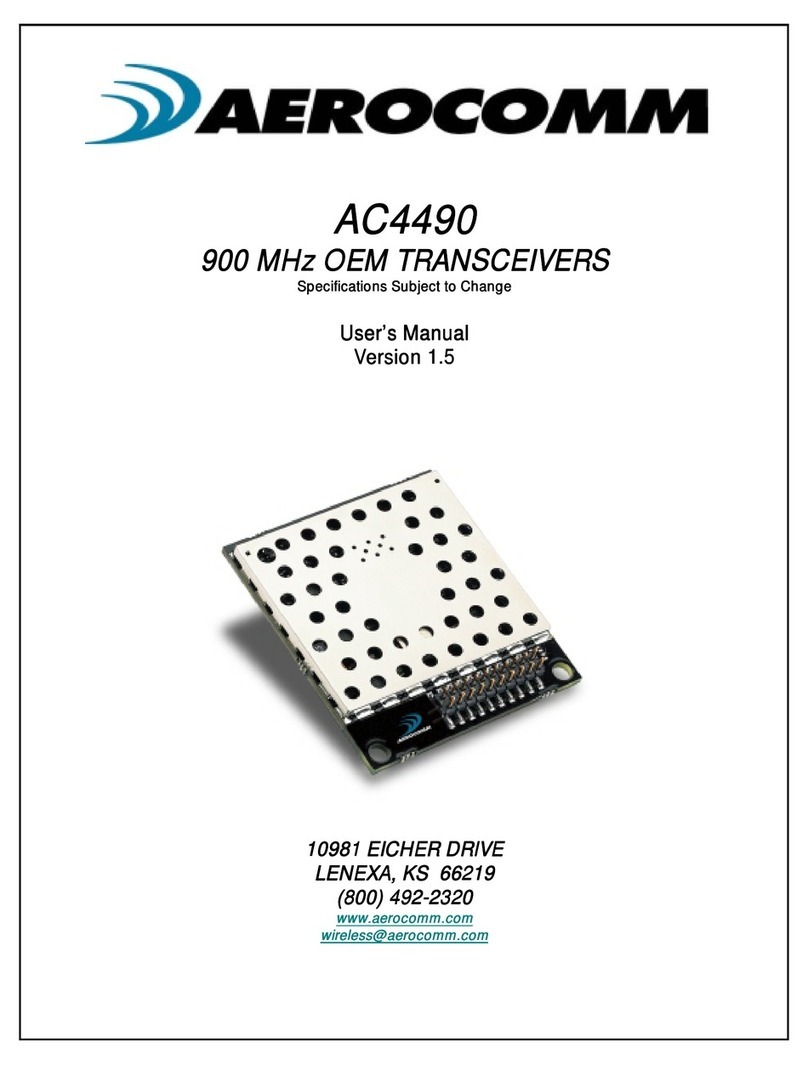
AeroComm
AeroComm AC4490 User manual
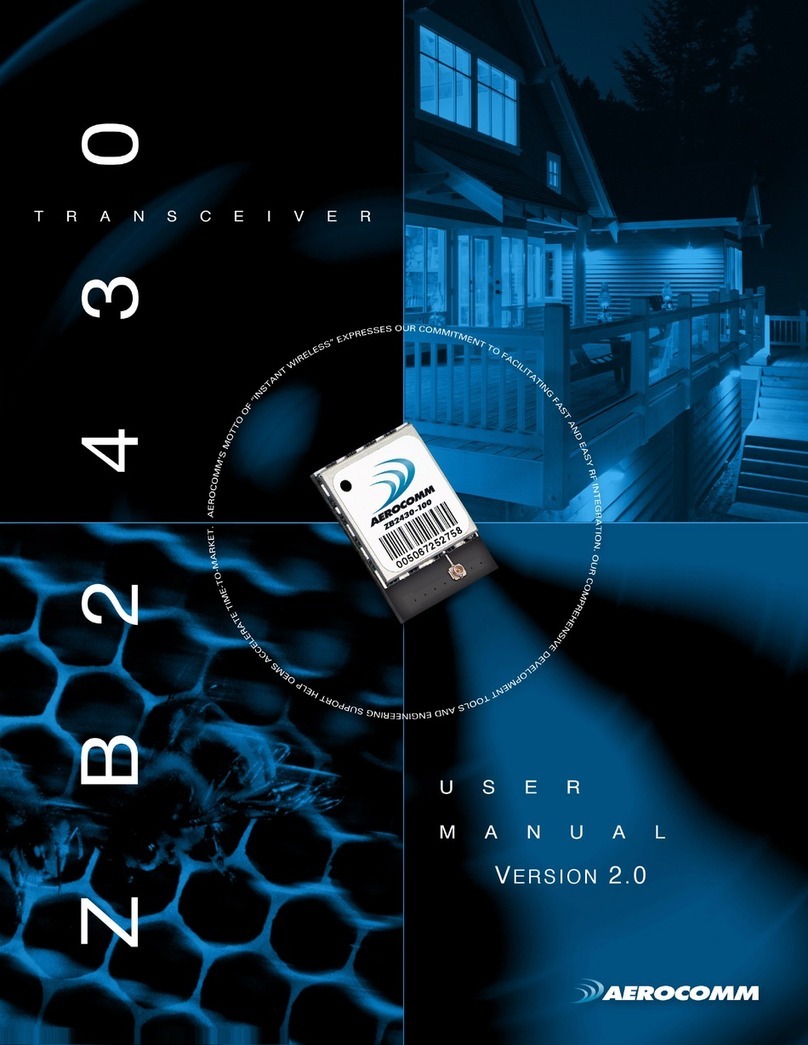
AeroComm
AeroComm TRANSCEIVER ZB2430 User manual

AeroComm
AeroComm AC4490 User manual

AeroComm
AeroComm CL4490-1000-485 User manual
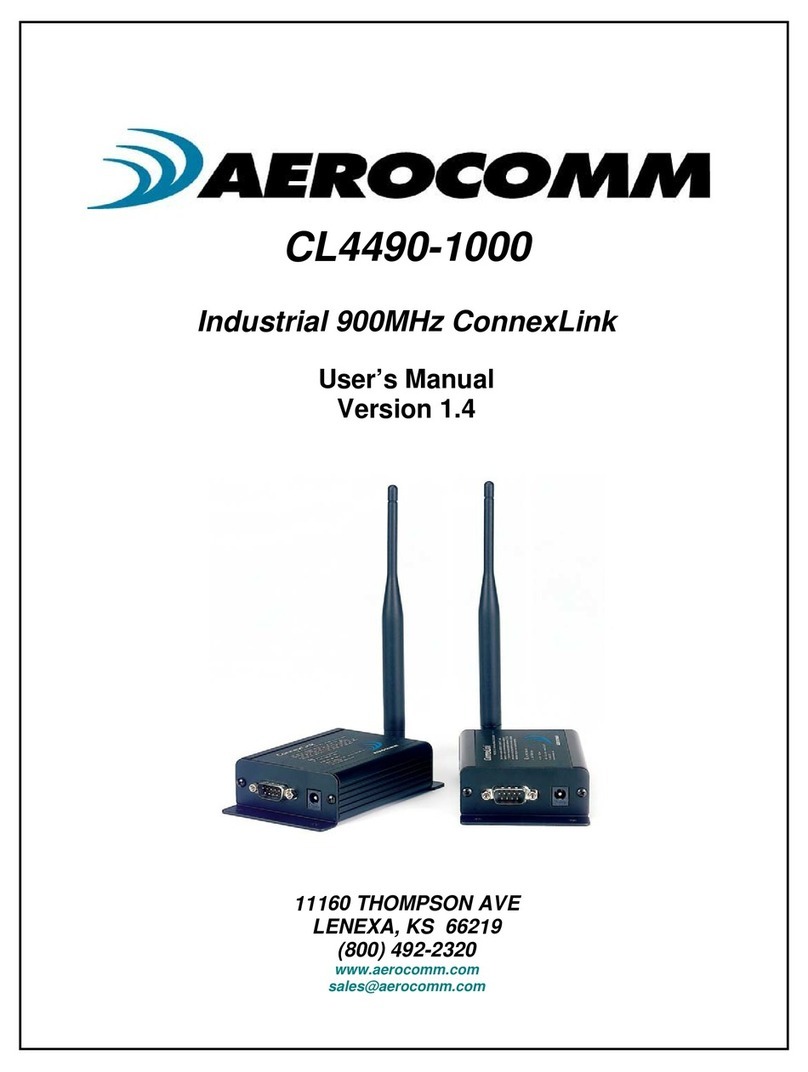
AeroComm
AeroComm CL4490-1000 User manual
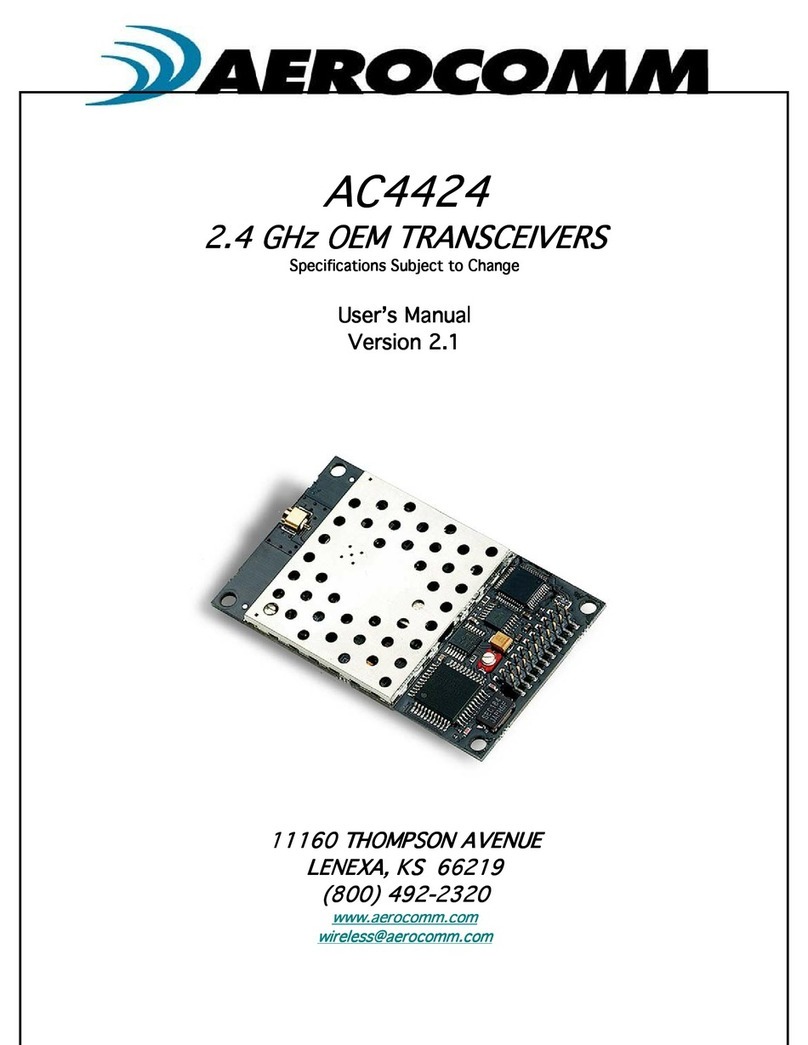
AeroComm
AeroComm AC4424 User manual
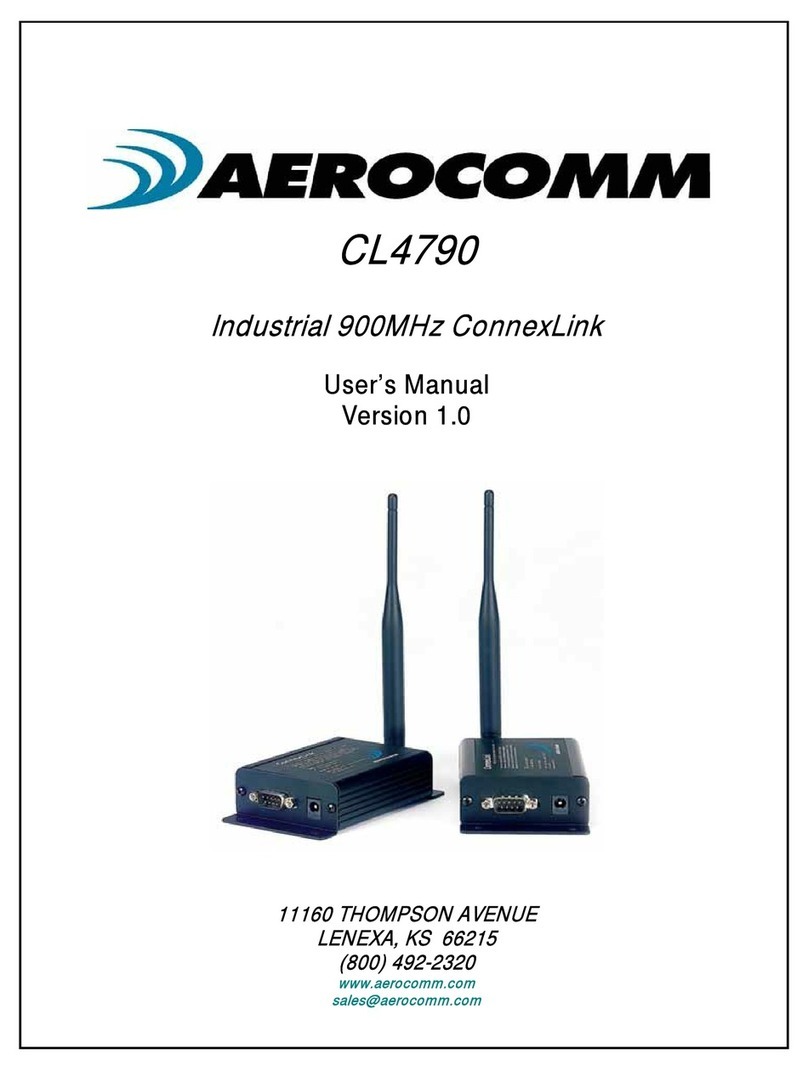
AeroComm
AeroComm CL4790 User manual
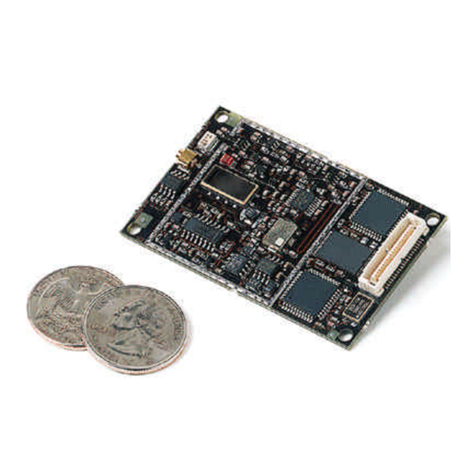
AeroComm
AeroComm PKLR2400S User manual

AeroComm
AeroComm AC4790 User manual
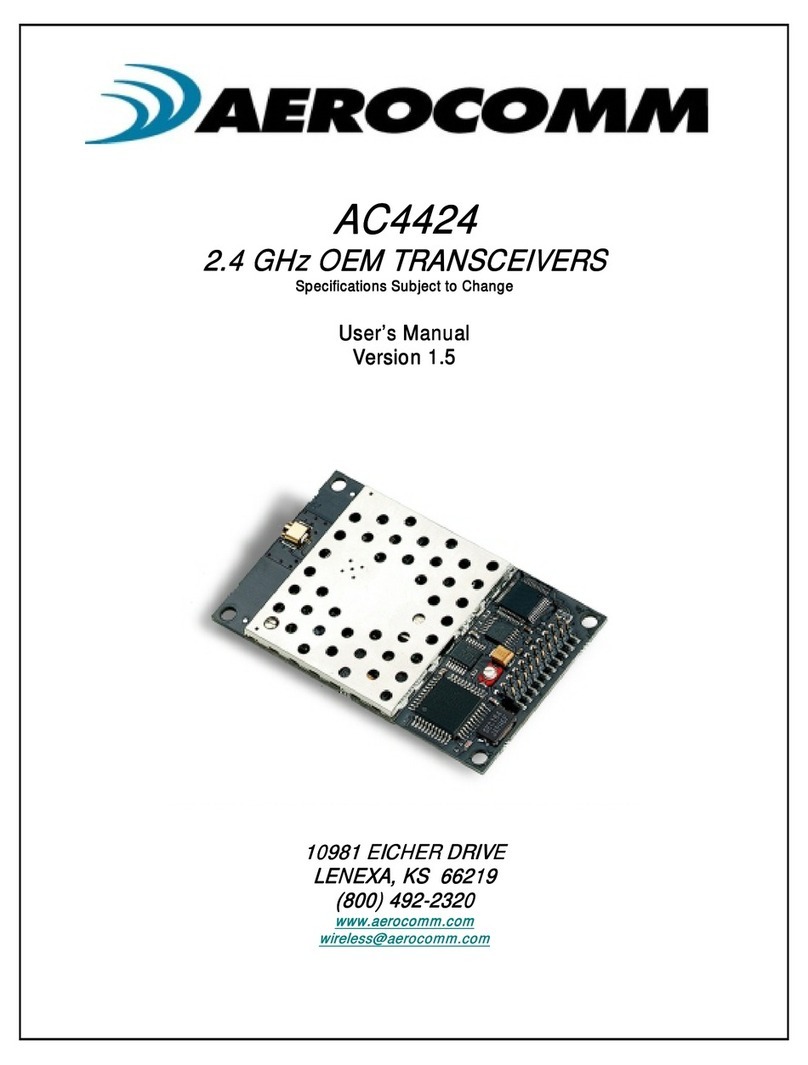
AeroComm
AeroComm AC4424-10 User manual

